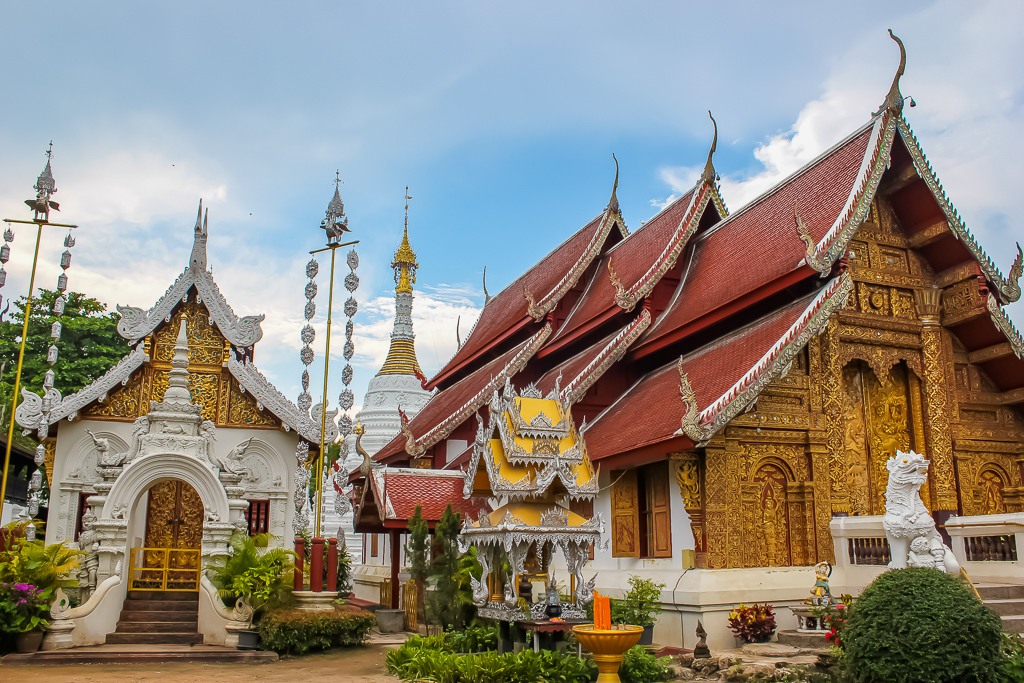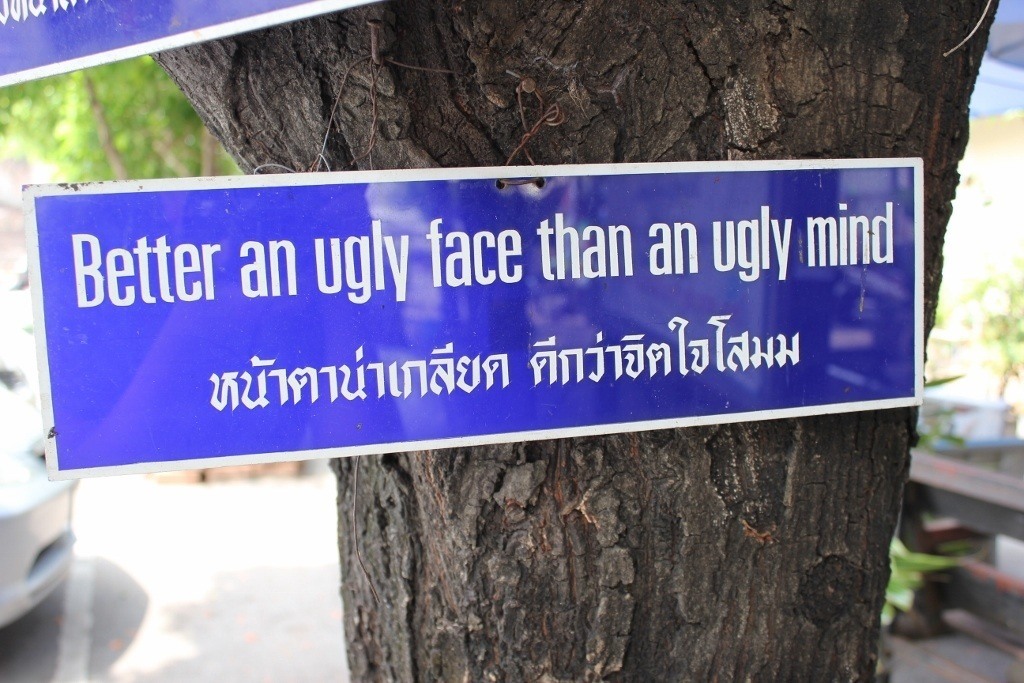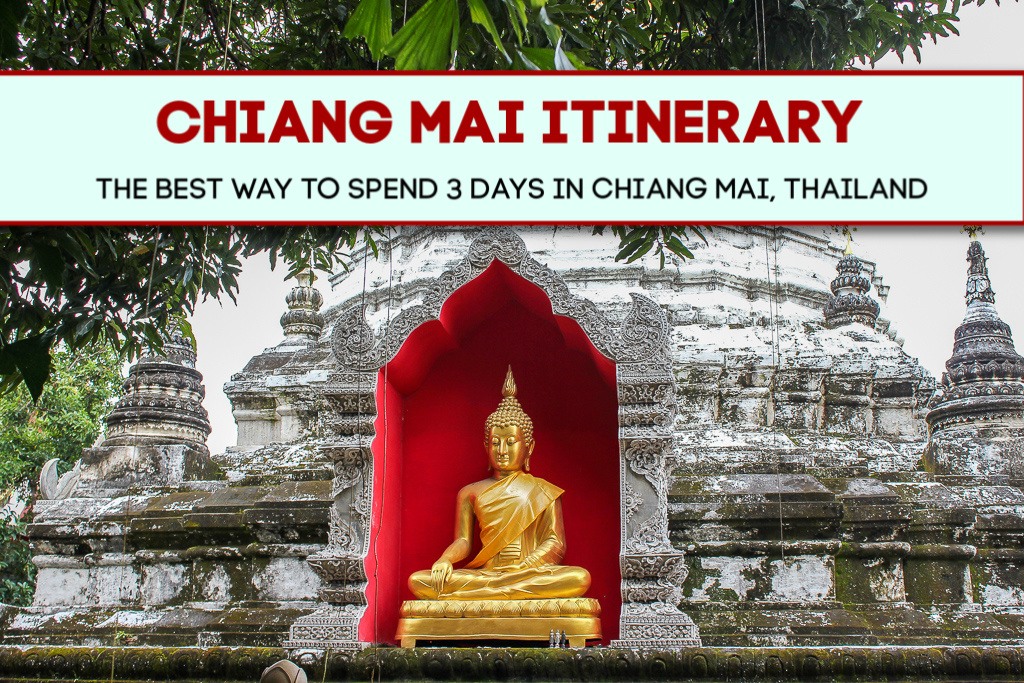With an ancient history, lush landscapes and captivating culture, it’s clear why Chiang Mai is one of the best cities to visit in Thailand. We’ve designed a perfect 3 Days in Chiang Mai Itinerary that explores the top highlights – and much more!
Our site utilizes Affiliate Links. If you use them to make a purchase, we may earn a commission. For more information, read our Disclosure Policy.
The Best Chiang Mai Itinerary
Trips to Chiang Mai can be relaxing and full of contemplation – or full throttle and filled with adventure. Visitors can see Chiang Mai on a budget – or splurge for a luxury vacation to Thailand.
Because travel styles are vastly different, we created a Chiang Mai Travel Itinerary that can be tailored to each individual.
We outline essential Chiang Mai activities, but offer ample alternatives so that you can adapt our itinerary for Chiang Mai into your perfect plan for visiting Northern Thailand!
3 Days in Chiang Mai, Thailand

Our detailed itinerary includes the absolute best things to do in Chiang Mai in 3 days. We’ll give you a taste of it all and likely leave you wanting to visit Chiang Mai again. So, we best get started!
Save, Pin or Bookmark our Chiang Mai Travel Guide to plan your trip to Thailand!
DAY 1: CHIANG MAI OLD TOWN

On the first day of your Chiang Mai 3-Day Itinerary, explore the best Old Town sights. Get a taste of traditional cuisine, experience a key part of the Thai culture and navigate your way through a Chiang Mai night market.
Chiang Mai Temple Tour

Begin your exploration of Chiang Mai on a Temple Tour. There are at least 30 temples within the Old City walls – and dozens more just steps from the city gates.
The most visited are the lavishly decorated temples that sit within sprawling complexes, but some of the unique Chiang Mai temples see relatively few visitors.

For travelers who are unfamiliar with Buddhism, it may be helpful to hire a Chiang Mai Tour Guide that can explain the traditions and significance of the temples. Read reviews of this popular tour.
Those who would rather see the temples on their own can use our detailed Chiang Mai Temples Guide. It includes all our recommended spots and a walking route to see all the best temples in Chiang Mai Old City!
Khao Soi Lunch

Khao Soi is the iconic dish of Northern Thailand – and it’s absolutely delicious. The spicy soup is a combination of noodles, meat and herbs that simmer in a coconut milk broth.
Each stemming bowl is topped with crispy noodles – then diners add a squeeze of lime, pickled cabbage and shallots to create their own version that best suits their tastes.

While Khao Soi is offered at numerous restaurants in Chiang Mai, the best place for the signature meal is at Khao Soi Khun Yai. Map.
The simple restaurant is located on the north side of the Old Town (conveniently near Wat Lok Moli). Open limited hours – 10am until 2pm Monday through Saturday (closed Sundays), make sure to keep an eye on the clock if you want a bowl of this famous Chiang Mai Khao Soi!
Chiang Mai Thai Massage

Getting a Thai massage in a Chiang Mai is must! The art of Thai massage has been used for thousands of years as a method of healing and rejuvenation.
Rather than soothing or tranquil, Thai massages use a technique of pressure, stretching and pulling. It can feel somewhat like visiting a chiropractor…but I think they are fabulous.
There are hundreds of places to get a massage in Chiang Mai. Every parlor and spa in the city offers a 1-hour Thai Massage, but additional services – like foot massages, oil massages and deeper spa treatments – are also available.
Prices for a traditional Thai massage start at around 200 baht ($6), but can cost significantly more at a luxury Chiang Mai massage spa.
Read our Complete Guide to Chiang Mai Massages!
Chiang Mai Night Markets

Chiang Mai has 3 night markets: The Saturday Night Market, The Sunday Night Market and the daily Night Bazaar.
Even though all three of the Chiang Mai markets are geared toward tourists, we find them highly entertaining.
Most of the items for sale are souvenirs (some handmade) and local eats. Vendors begin setting up around 4:00pm – and all the markets in Chiang Mai are in full swing by 7:00pm.
Saturday Night Market (Wua Lai Walking Street)

Of the three, the Saturday Walking Street Market is our favorite. The market takes place along Wua Lai Street, just outside the south Chiang Mai city gate.
After perusing the goods, we recommend dining on local fare from one of the popular vendors near the Pratu Gate.
Sunday Night Market
The Sunday Market – also called the Tha Pae Walking Street Market – is located inside the Old City, occupying Rachadamnoen Road from Tha Phae Gate west to the city center.
Although more congested than the Saturday Market, people watching while having a delicious meal on the grounds of Wat Pan On is very entertaining!
Chiang Mai Night Bazaar
The Chiang Mai Night Bazaar is east of the Old Town along Changklan Road. Offering similar goods as the Saturday and Sunday markets, the Bazaar takes places nightly and has a larger variety of food vendors and sometimes live music.
DAY 2: CHIANG MAI DAY TRIPS

On the second day of your Chiang Mai 3-Days Itinerary, discover beyond the Old City walls on one of the best day trips from Chiang Mai.
Chiang Mai Tours

One of the great things about Chiang Mai is its proximity to amazing nature, additional top sights and other interesting towns.
Tours from Chiang Mai take visitors into the mountains and to play with elephants, to famous temples and tea plantations, and to northern Thai cities and hill tribe villages.
Choosing a Day Trip from Chiang Mai

Deciding which Chiang Mai tour – or tours – to take can be overwhelming; there are just so many options!
There are half-day, full-day and multi-day tours; big bus tours, small group tours and personalized tours; cheap, mid-range and luxury tours.
We believe the best way to wade through the options is to read reviews from fellow travelers. Organized Chiang Mai tour providers like Viator and Get Your Guide allow you to sort through the tours, clearly see inclusions, exclusions and pour through the reviews.

We have only taken one organized Chiang Mai tour, an all-day trekking trip that included numerous activities.
This included playing with elephants, bamboo rafting, visiting a hill tribe, hiking through the forest and swimming at a waterfall.
In the end, the tour fell short of our expectations – and, in hindsight, we would have chosen a different one.
Read our full Chiang Mai Trekking Trip review.
More Excursions from Chiang Mai

These top-rated and popular Chiang Mai day trips come recommended by fellow travelers!
Chiang Mai Ethical Elephant Camp
While elephant camps have long been a Thailand attraction, poor treatment of the animals has come to light. Finding an ethical elephant sanctuary in Chiang Mai can be difficult – but not impossible.
The Ran-Tong Save & Rescue Elephant Centre allows visitors to get up-close and personal with the gentle giants, but does not allow participants to ride the elephants. Find out more!
Chiang Rai and Golden Triangle

One of the most popular tours is from Chiang Mai to Chiang Rai and the Golden Triangle. The day trip from Chiang Mai includes visiting the famous White Temple and seeing the ancient city of Chiang Saen.
Plus, riding a boat on the Khong River and exploring the Golden Triangle, the point where Myanmar, Laos and Thailand converge. Get the details!
Top Tip: Rather than seeing the city on a day trip, we stayed in Chiang Rai for a week. We have more suggestions for a Chiang Rai-Chiang Mai Itinerary below!
Chiang Mai Mountain Doi Suthep

Sitting west of the Chiang Mai Old City is Doi Suthep Mountain. Numerous day trips from Chiang Mai explore the mountain that is known for its lush nature, dazzling temples and incredible adventures.
Some of the top activities include visiting the iconic Doi Suthep Temple, going to a hill tribe village and hiking to hidden waterfalls and stellar viewpoints.
Dinner: Pork Leg Rice

After you return from your day trip, indulge in a scrumptious meal of stewed Pork Leg Rice from a famous Chiang Mai food vendor, the Cowboy Hat Lady.
Located outside the north gate at the Chang Phueak Night Food Market, Khao Kha Moo Chang Phueak – map – is the best place in Chiang Mai for Thai-style braised pork leg.
The pork is first simmered to perfection. Served over steamed rice and covered in sauce, it’s best with a sprinkle of pickled vegetables and an egg on the side.
Some say the Cowboy Hat Lady makes the absolute best stewed pork in all of Thailand. The stall is so well-known that even the late Anthony Bourdain dined there. Watch the clip.
DAY 3: THAI CULTURE

Use the last day of your three days in Chiang Mai to learn more about the local Thai culture…and eat more delicious Chiang Mai food.
Local Chiang Mai Market

An ideal way to get a glimpse of local life is to visit the markets where residents do their daily shopping. In Chiang Mai, the most popular day market is Warorot Market in Chinatown, which is just a short walk (or Grab Taxi ride) from the Old Town.

The massive shopping complex offers everything under the sun. Freshly ground spices overflow from barrels. Flies buzz around the piles of exotic produce and raw meat.
Clothing, jewelry, electronics and luggage are all crammed into small spaces that are navigated by narrow lanes. The heat is oppressive and the scents are potent…and we love it!

Top Tip: Prepared market food is also available and is a great opportunity to try several different dishes. Look for food vendors that have the longest lines and order what the locals are ordering!
Chiang Mai Cooking Class

Participating in a cooking class is another excellent way to understand the market, food and eating culture of Thailand.
The school’s chef leads the attendees to a local market to gather produce, meat and spices for the day’s meal, explaining different fruits, vegetables and herbs during the visit.
Back at the school, guests are guided through the process of making an incredible array of local eats. Lunch is guaranteed to be a feast. Read the reviews!
Monk Chat, Meditation, Museums (or a Swim!)

In the afternoon, spend time chatting with a monk, taking a class on meditation or visiting one of the top Chiang Mai museums.
If you just need time to relax, go for a refreshing swim at your hotel pool or chill out in a Chiang Mai café.
Monk Chat

Monk Chat is a fabulous way to learn more about the temples, monks, Buddhism and Thailand. Many of the temples offer the opportunity for tourists to converse with monks.
We had an amazing monk chat with fellow travelers at Wat Chedi Luang, where they offer daily chats from 9am until 6pm.
Meditation or Yoga Class

There are numerous places around Chiang Mai that offer classes on meditation and yoga. Courses last from a couple of hours to month-long retreats. Search and read reviews!
Chiang Mai Museums
We didn’t actually visit any museums on our trips to Chiang Mai, but they would make an excellent escape from the afternoon heat or monsoon rains. Top Chiang Mai museums are the Art in Paradise Museum, the Museum of World Insects and Natural Wonders and the National Museum.
Cool Off With A Swim
Rather than Chiang Mai sightseeing, grab a good book and cool off with a refreshing swim at your hotel pool. Find our tips below for where to stay in Chiang Mai with a pool.
Staying at a hotel without a pool? Take a short trip out to the Chiang Mai Grand Canyon Water Park. Find out more!
Dinner: Classic Thai Food

For your final meal in Chiang Mai, enjoy a traditional Thai dish – such as Pad Thai, Papaya Salad or Phanaeng Curry.
There is no shortage of places to eat Thai food in Chiang Mai. That said, we highly recommend eating at Aroy Dee, Kanjana, Lucky Too or Teng Nueng. Use this map to find all of our favorite Chiang Mai restaurants.
Read more of the Best Things To Do in Chiang Mai!
Chiang Mai Itinerary Travel Tips

Ready to launch off to Northern Thailand? Great! We’ve got a few hacks and honest advice to help make your Thailand Itinerary better.
Top Tip: Get (and stay) organized for your vacation to Thailand with our Trip Planning Printables!
How Long To Stay in Chiang Mai, Thailand

When deciding how long to spend in Chiang Mai, there are several factors to consider – like budget, interest and time allotted for your entire SE Asia trip.
We feel 3 Days in Chiang Mai is just enough time to get a feel for the city. That said, our trips to Chiang Mai have always been longer and have never struggled finding fun things to do!
Best Time to Visit Chiang Mai

The weather in Chiang Mai can severely affect any trip to the city. Year round, Chiang Mai experiences hot and humid temperatures. You can expect highs in the upper 80s to low 90s Fahrenheit.
The Chiang Mai rainy season lasts from May to October – and, historically, August in the wettest month. The dry season is from late October through April; January is typically the coolest month in Chiang Mai.
How To Get to Chiang Mai

Chiang Mai can be reached by airplane, train, bus or car. Flying and taking the train are the two most popular options for traveling to Chiang Mai from Bangkok.
On our visits, we have arrived via plane from Phuket and Krabi and departed on flights to Hanoi and Siem Reap.
Chiang Mai Airport
The Chiang Mai International Airport (CNX) is located southwest of the Old City. It’s about a 10-minute taxi ride from the airport to the city center and the flat-rate taxi should be less than $10.
Start your search for the lowest airfare to Chiang Mai on SkyScanner!
Chiang Mai Train Station
The Chiang Mai Railway Station (CGM) is located east of the Old City, across the Ping River. The station has limited service and is mostly used to connect Chiang Mai to Bangkok.
Where To Stay in Chiang Mai, Thailand

With just 3 days in Chiang Mai, it’s important to stay somewhere centrally located. Our favorite area to stay in Chiang Mai is the northeast corner of the Old Town.
We spent hours – maybe days – researching the best place to stay in Chiang Mai. The factors we considered for booking a hotel were location, amenities and cost.
Chada Mantra Boutique Hotel
For our most recent trips to Chiang Mai, we stayed in the Chada Mantra Hotel. The boutique hotel is ideally located in a great area of the Old Town.
The rooms are spacious, clean and bright with ice-cold air con. Our top-floor, corner room had two balconies that overlooked the street, which was busy during the day but quiet at night.
Things To Pack for Chiang Mai

When preparing for your trip to Chiang Mai, don’t forget to read our Ultimate Packing List and Best Packing Hacks!
Bug Spray and Sun Protection
Don’t let pesky mosquitoes or a dreadful sunburn hinder your vacation to Thailand. Remember to pack good insect repellent and protective sunscreen!
A wide-brimmed travel hat or compact umbrella are also useful for combating the intense sun rays of Southeast Asia.
Travel Camera
Rather than relying on your phone to capture the images of amazing Thailand, we recommend upgrading to a real camera for high quality photos.
We travel with a Canon Rebel with a 18-135mm lens, it’s a great budget camera and the kit comes with tons of accessories!
Day Pack
Whether you travel with a backpack or a suitcase, you will also want to have a great day bag to organize and secure all of your essential everyday travel items!
Thailand Travel Insurance
Trip insurance may cover expenses incurred for a wide range of inconveniences – such as injuries, illnesses and even flight delays or lost luggage. Find rates and a full list of coverages at World Nomads.
Start planning your trip to Thailand! Search for the lowest airfares, the best accommodations and fun things to do…then start packing! Want additional tips? Head over to our Travel Planning Page for more advice on traveling – and for country-specific information, take a look at our Travel Guides Page!
Pin it! See all of our travel pins on our JetSetting Fools Pinterest Board.






